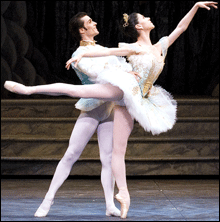
SLEEPING BEAUTY: Paloma Herrera started
out bland, but Ángel Corella got her cranked
up.
|
NEW YORK — The big ballet companies are shackled tighter than ever to the idea of the story ballet. The Swan Lakes and the Cinderellas are a failsafe audience draw; the problem is, they seem to need freshening up every so often. It’s a paradox: you have to preserve the successful formula while attracting attention for doing something new. The rehab job can involve anything from touching up the costumes to tearing the poor old structure down to the bones and building a McBallet. Or — what’s considerably harder — you can find another story to tell.
With The Nightingale and the Rose, which premiered last Friday at New York City Ballet, Christopher Wheeldon has come up with a rarity, a new fairy-tale ballet. Even rarer, he’s made a piece of poetry for the stage. Based on an Oscar Wilde fairy tale, the ballet has a commissioned score by Bright Sheng and a spare visual presentation: costumes by Martin Pakledinaz, animation by James Buckhouse, lighting by Mark Stanley. In a single act, Wheeldon and his collaborators create a mood and a look — a dream message about how little we understand the cost of beauty.
The Nightingale and the Rose isn’t your usual happily-ever-after fantasy. It does have a hero in love, and a wild creature who helps him. But the story turns bitter. The nightingale promises to bring the student a red rose for the girl he loves. The only red rosebush in the garden is dried up and dormant, but it agrees to produce a flower if the nightingale will sing all night with her breast pressed against its thorn. As she dies, a blood-red rose blooms. The girl proves fickle and rejects the rose that’s been obtained at such sacrifice. The student shrugs off his bruised ego and walks away, dropping the rose and stepping over the expiring bird who gave her life for it.
The wonderful thing about Wheeldon’s work is that he’s found a way to get this across without literalness or melodrama. His unsentimental eye sees the harshness of this bargain, and also the beauty. There’s a simplicity, a starkness to the ballet that resembles some Asian theater forms. You may not know exactly what’s happening at every moment, but you feel the injustice and the inevitability.
The ballet begins in silence before the sounds of birds fill the dark theater. We find Wendy Whelan center stage, encircled by two large calligraphic brushstrokes projected on a front scrim. Instead of doing a conventional ballet-bird imitation, she moves the way birds actually do, with angular, stopped gestures aimed in all directions, hands fluttering behind her, upper body and head thrust out. All of a sudden she runs across the stage and lofts into the air, courtesy of some black-clad men who catch her and fly her off. They’re like the near-invisible stage managers who help kabuki actors make magic transformations. Just as Whelan leaves the ground, the orchestra plays its first note, and a large moon appears.
Whelan dances then, streaking around the stage with the same sort of jutting shapes, a solitary bird woman singing to herself. The student (Tyler Angle) pursues the girl (Sara Mearns), who coyly rebuffs him and runs off. Then in a duet, the student tells the nightingale of his longing and they seal their bargain with a flower gesture that looks like the lotus mudra in Indian dance, upturned hands pressed together, the fingers opening like petals.
Groups of four women, as white and yellow rosebushes, cluster together like closing blossoms. They’re not the flower the nightingale seeks. When she finds the shriveled red rose, the scrim flies out and a huge blinking eye veils the moon. The red rosebush, at first two men knotted together like a gnarled brown twig, accepts the nightingale, and as she perches on their writhing shape, patches of red appear on their legs and arms. More and more men add to the growing plant. Eventually there are 16 in all, with bigger and bigger red patches on their brown unitards.
Whelan languishes against them, not using her arms, as they support her and wrap themselves around her. They create a succession of blossoming shapes. Whelan grows weaker, pushing through the solid bark they’re forming around her, until she’s absorbed into their midst and a single flower rises where she disappeared.
Bright Sheng’s music — he conducted the two performances I saw over the weekend — is atmospheric, lightly Chinese-influenced, with strings, brasses, flutes, and a lot of percussion. Like the ballet, it’s full of gorgeous color and pitiless clarity, fastidiously modern.